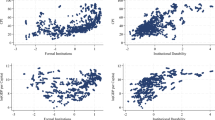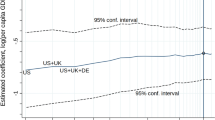Abstract
We analyze favors as utilization of informal modes of exchange within a formal economy, relating their negative aspects to corruption. This exercise enables us to integrate them into a model linking national institutional factors to the magnitude of cross-country FDI flows. In our empirical tests of FDI inflows in 55 countries across four distinct time periods, we find that the level of economic regulation is a major determinant of the extent of FDI inflows as well as the level of corruption, but corruption does not have an independent influence on levels of FDI inflows. Our results have important policy implications regarding the role of the state in influencing the location decisions of MNEs.


Similar content being viewed by others
References
Adam, A., & Filippaios, F. 2007. Foreign direct investment and civil liberties: A new perspective. European Journal of Political Economy, 23(4): 1038–1052.
Ades, A., & Di Tella, R. 1997. National champions and corruption: Some unpleasant interventionist arithmetic. Economic Journal, 107: 1023–1042.
Ades, A., & Di Tella, R. 1999. Rents, competition and corruption. American Economic Review, 89(4): 982–993.
Aguilera, R., & Vadera, A. 2008. The dark side of authority: Antecedents, mechanisms and outcomes of organizational corruption. Journal of Business Ethics, 77(4): 431–449.
Asian Development Bank. 2006. Second governance and anti-corruption action plan. Manila: ADB/OECD.
Bardhan, P. 1997. Corruption and development: A review of the issues. Journal of Economic Literature, 35(3): 1320–1346.
Becker, G. S. 1968. Crime and punishment: An economic approach. Journal of Political Economy, 76: 169–217.
Bengoa, M., & Sanchez-Robles, B. 2003. Foreign direct investments, economic freedom and growth: New evidence from Latin America. European Journal of Political Economy, 19(3): 529–545.
Bliss, C., & Di Tella, R. 1997. Does competition kill corruption?. Journal of Political Economy, 105: 1001–1023.
Bowden, R. J., & Turkington, D. A. 1984. Instrumental variables. Cambridge: Cambridge University Press.
Buchanan, J. M., & Tullock, G. 1962. The calculus of consent: Logical foundations of constitutional democracy. Ann Arbor: University of Michigan Press.
Cantwell, J. A. 1995. The globalisation of technology: What remains of the product cycle model?. Cambridge Journal of Economics, 19(1): 155–174.
Cantwell, J. A., & Mudambi, R. 2000. The location of MNE R&D activity: The role of investment incentives. Management International Review, 40(Special Issue 1): 127–148.
Cheng, L. K., & Kwan, Y. K. 2000. What are the determinants of the location of foreign direct investment? The Chinese experience. Journal of International Economics, 51(2): 379–400.
Coate, S., & Morris, S. 1999. Policy persistence. American Economic Review, 89: 1327–1336.
Cuervo-Cazurra, A. 2008. The effectiveness of laws against bribery abroad. Journal of International Business Studies, 39(4): 634–651.
Cuervo-Cazurra, A., & Dau, L. A. 2009. Pro-market reforms and firm profitability in developing countries. Academy of Management Journal, 52(6): 1348–1368.
Cumings, B. 1984. The origins and development of the Northeast Asian political economy: Industrial sectors, product cycles, and political consequences. International Organization, 38(1): 1–40.
De Haan, J., Lundstrom, S., & Sturm, J. E. 2006. Market-oriented institutions and policies and economic growth: A critical survey. Journal of Economic Surveys, 20(2): 157–191.
Dehejia, V. H., & Weichenrieder, A. J. 2001. Tariff jumping foreign investment and capital taxation. Journal of International Economics, 53(1): 223–230.
De Soto, H. 1990. The other path. New York: Harper and Row.
Djankov, S., La Porta, R., Lopez-de-Silanes, F., & Shleifer, A. 2002. The regulation of entry. Quarterly Journal of Economics, 117(1): 1–37.
Doh, J. P., Rodriguez, P., Uhlenbruck, K., Collins, J., & Eden, L. 2003. Coping with corruption in foreign markets. Academy of Management Executive, 17(3): 114–127.
Doucouliagos, C., & Ulubasoglu, M. A. 2006. Economic freedom and economic growth: Does specification make a difference?. European Journal of Political Economy, 22(1): 60–81.
Dreher, A., & Rupprecht, S. M. 2007. IMF programs and reforms: Inhibition or encouragement?. Economics Letters, 95(3): 320–326.
Dunning, J. H. 1993. Multinational enterprises and the global economy. Reading, MA: Addison-Wesley.
Fisman, R., & Gatti, R. 2006. Bargaining for bribes: The role of institutions. In S. Rose-Ackerman (Ed.). International handbook on the economics of corruption: 127–139. Cheltenham, UK: Edward Elgar.
Gillespie, K., & McBride, B. 1996. Smuggling in emerging markets: Global implications. Columbia Journal of World Business, 31(4): 40–54.
Greene, W. 1997. Econometic analysis. Upper Saddle River, NJ: Prentice Hall.
Habib, M., & Zurawicki, L. 2002. Corruption and foreign direct investment. Journal of International Business Studies, 33(2): 291–307.
Harms, P., & Ursprung, H. W. 2002. Do civil and political repression really boost foreign direct investments?. Economic Inquiry, 40: 651–663.
Heineman, B. W., & Heimann, F. 2006. The long war against corruption. Foreign Affairs, 85(3): 75–86.
Henisz, W. J., & Delios, A. 2004. Information or influence: The benefits of experience for managing political uncertainty. Strategic Organization, 2: 389–421.
Hines, J. R., Jr. 1995. Forbidden payments: Foreign bribery and American business after 1997. NBER Working paper no. 5266, National Bureau of Economic Research, Cambridge, MA.
Holmes, S., & Cass, R. S. 1999. The cost of rights: Why liberty depends on taxes. New York: W. W. Norton & Company.
Husted, B. W. 1994. Honor among thieves: A transaction-cost interpretation of corruption in the Third World. Business Ethics Quarterly, 4(1): 17–27.
Husted, B. 1999. Wealth, culture and corruption. Journal of International Business Studies, 30(2): 339–359.
Institute for Global Ethics. 2006. Aggressive World Bank anti-corruption policies prompt backlash from critics. Ethics Newsline, 9(39): 1.
Jakobsen, J., & de Soysa, I. 2006. Do foreign investors punish democracy? Theory and empirics, 1984–2001. Kyklos, 59(3): 383–410.
Kinal, T. W. 1980. The existence of moments of κ-class estimators. Econometrica, 48(1): 241–249.
Klitgaard, R. E. 1988. Controlling corruption. Berkeley: University of California Press.
Knack, S., & Azfar, O. 2003. Trade intensity, country size and corruption. Economics of Governance, 4(1): 1–18.
Kumaraswamy, A., Mudambi, R., Saranga, H., & Tripathy, A. 2012. Catch-up strategies in the Indian auto components industry: Domestic firms’ responses to market liberalization. Journal of International Business Studies, 43(4): 368–395.
La Porta, R., Lopez-de-Silanes, F., & Shleifer, A. 2008. The economic consequences of legal origins. Journal of Economic Literature, 46(2): 285–332.
Laffont, J. J. 1996. Regulation, privatization and incentives in developing countries. In M. G. Quibria & J. M. Dowling (Eds.). Current issues in economic development. Oxford: Oxford University Press.
Lambsdorff, J. G. 1999. Corruption in empirical research: A review. Working paper, Transparency International, Berlin.
Lambsdorff, J. G. 2003. How corruption affects persistent capital flows. Economics of Governance, 4(3): 229–243.
Li, Q., & Resnick, A. 2003. Reversal of fortunes: Democratic institutions and foreign direct inflows to developing countries. International Organization, 57(1): 175–211.
Lomnitz, L. 1988. Informal exchange networks in formal systems: A theoretical model. American Anthropologist, 90(1): 42–55.
Luo, Y. 2002. Corruption and organization in Asian management systems. Asia Pacific Journal of Management, 19(4): 405–422.
Maidment, F., & Eldridge, W. 1999. Business, government and society. Englewood Cliffs, NJ: Prentice-Hall.
Manion, M. 1996. Corruption by design: Bribery in Chinese enterprise licensing. Journal of Law, Economics and Organization, 12(1): 167–195.
Mudambi, R. 1998. The role of duration in MNE investment strategies. Journal of International Business Studies, 29(2): 239–262.
Mudambi, R., Navarra, P., & Paul, C. 2002. Institutions and market reform in emerging economies: A rent seeking perspective. Public Choice, 112(1): 185–202.
Mudambi, R., & Paul, C. 2003. Domestic drug prohibition as a source of foreign institutional instability: An analysis of the multinational extra-legal enterprise. Journal of International Management, 9(3): 335–349.
Mutti, J., & Grubert, H. 2004. Empirical asymmetries in foreign direct investment and taxation. Journal of International Economics, 62(2): 337–358.
Myrdal, G. 1970. Corruption as a hindrance to modernization in South Asia. In A. J. Heidenheimer & M. Johnston (Eds.). Political corruption: Concepts and contexts. New Brunswick, NJ: Transaction Publishers.
Niskanen, W. 1968. Non-market decision making: The peculiar economics of bureaucracy. American Economic Review, 58(2): 293–305.
Ordover, J., Pittman, R., & Clyde, P. 1994. Competition policy for natural monopolies in a developing market economy. Economics of Transition, 2: 317–343.
Paldam, M. 2002. The cross-country pattern of corruption: Economics, culture and the seesaw dynamics. European Journal of Political Economy, 18(2): 215–240.
Pigou, A. C. 1947. A study in public finance, 3rd ed. London: Macmillan.
Polinsky, M. A., & Shavell, S. M. 2000. The economic theory of public enforcement of law. Journal of Economic Literature, 38: 45–76.
Rodriguez, P., Uhlenbruck, K., & Eden, L. 2005. Government corruption and entry strategies of multinationals. Academy of Management Review, 30(2): 383–396.
Rose-Ackermam, S. 1988. Bribery. In J. Eatwell, M. Milgate & P. Newman (Eds.). The New Palgrave Dictionary of Economics. London: Macmillan.
Rose-Ackermam, S. 1999. Corruption and government: Causes, consequences and reform. New York: Cambridge University Press.
Shavell, S. M. 1993. The optimal structure of law enforcement. Journal of Law and Economics, 36(2): 255–287.
Shenkar, O. 2001. Cultural distance revisited: Toward a more rigorous conceptualization and measurement of cultural differences. Journal of International Business Studies, 32(3): 519–535.
Shleifer, A., & Vishny, R. 1993. Corruption. Quarterly Journal of Economics, 108(3): 599–617.
Shleifer, A., & Vishny, R. 1999. The grabbing hand. Cambridge: Harvard University Press.
Smarzynska, B. K., & Wei, S. J. 2002. Corruption and cross-border investment: Firm-level evidence. Working paper no. 494, William Davidson Institute, Ann Arbor, MI.
Stigler, G. J. 1970. The optimum enforcement of laws. Journal of Political Economy, 78: 526–536.
Stigler, G. J. 1971. The theory of economic regulation. Bell Journal of Economics, 12: 3–21.
Tanzi, V. 1998. Corruption around the world: Causes, consequences, scope and cures. IMF Staff Papers, 45(4): 559–594.
Trevino, L. J., Daniels, J. D., Arbelaez, H., & Upadhyaya, K. P. 2002. Market reform and foreign direct investment in Latin America: Evidence from an error correction model. International Trade Journal, 16(4): 367–392.
Tung, S., & Cho, S. 2001. Determinants of regional investment decisions in China: An econometric model of tax incentive policy. Review of Quantitative Finance and Accounting, 17: 167–185.
United Nations. 2001. United Nations manual on anti-corruption policy. Vienna: Global Programme against Corruption, Centre for International Crime Prevention, Office of Drug Control and Crime Prevention.
Verbeke, A., & Greidanus, N. 2009. The end of the opportunism vs. trust debate: Bounded reliability as a new envelope concept in research on MNE governance. Journal of International Business Studies, 40: 1471–1495.
Verbeke, A., & Kano, L. 2013. A transaction cost economics (TCE) theory of trading favors. Asia Pacific Journal of Management, this issue.
Voyer, P. A., & Beamish, P. W. 2004. The effect of corruption on Japanese foreign direct investment. Journal of Business Ethics, 50(3): 211–224.
Wei, S. J. 2000. How taxing is corruption on international investors?. Review of Economics and Statistics, 82(1): 1–11.
Wheeler, D., & Mody, A. 1992. International investment location decisions: The case of U.S. firms. Journal of International Economics, 33(1–2): 57–76.
World Bank. 2011. Trends in corruption and regulatory burden in Eastern Europe and Central Asia. Washington, DC: The World Bank.
Zhou, J. Q., & Peng, M. W. 2013. Does bribery help or hurt firm growth around the world?. Asia Pacific Journal of Management. doi:10.1007/s10490-011-9274-4.
Author information
Authors and Affiliations
Corresponding author
Appendix
Appendix
Emerging and developing economies in the dataset:
Argentina, Bolivia, Botswana, Brazil, Cameroon, Chile, P.R. China, Colombia, Congo Dem. R., Costa Rica, Dominican Rep., Ecuador, Egypt, El Salvador, Gabon, Ghana, Guatemala, Haiti, Honduras, India, Indonesia, Iran, Jamaica, Jordan, Madagascar, Malawi, Malaysia, Mali, Mauritius, Mexico, Morocco, Nigeria, Pakistan, Panama, Papua New Guinea, Paraguay, Peru, Philippines, Poland, Rwanda, Senegal, Sierra Leone, South Korea, Sri Lanka, Syria, Thailand, Togo, Trinidad and Tobago, Tunisia, Turkey, Uganda, Uruguay, Venezuela, Zambia, Zimbabwe.
Rights and permissions
About this article
Cite this article
Mudambi, R., Navarra, P. & Delios, A. Government regulation, corruption, and FDI. Asia Pac J Manag 30, 487–511 (2013). https://doi.org/10.1007/s10490-012-9311-y
Published:
Issue Date:
DOI: https://doi.org/10.1007/s10490-012-9311-y




